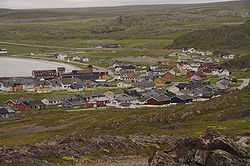Kiberg
| Kiberg Kiiperi | |
|---|---|
| Village | |
 | |
 Kiberg | |
| Coordinates: 70°17′07″N 30°59′53″E / 70.28528°N 30.99806°ECoordinates: 70°17′07″N 30°59′53″E / 70.28528°N 30.99806°E | |
| Country | Norway |
| Region | Northern Norway |
| County | Finnmark |
| District | Øst-Finnmark |
| Municipality | Vardø |
| Area[1] | |
| • Total | 0.38 km2 (0.15 sq mi) |
| Elevation[2] | 3 m (10 ft) |
| Population (2012)[1] | |
| • Total | 205 |
| • Density | 539/km2 (1,400/sq mi) |
| Time zone | CET (UTC+01:00) |
| • Summer (DST) | CEST (UTC+02:00) |
| Post Code | 9960 Kiberg |
Kiberg (Kven: Kiiperi) is a village in Vardø Municipality in eastern Finnmark county, Norway. It is located on the eastern end of the Varanger Peninsula, along the Barents Sea. Kiberg is the second largest settlement in Vardø municipality. It is situated about 10 kilometres (6.2 mi) southwest of the municipal centre, the town of Vardø. Kibergneset (Cape Kiberg) is the easternmost spot on the Norwegian mainland, and it is located just east of the village. The 0.38-square-kilometre (94-acre) village has a population (2012) of 205, which gives the village a population density of 539 inhabitants per square kilometre (1,400 /sq mi).[1]
History

Witch Burning
Two women from Kiberg, Mari Jørgensdatter and Kirsti Sørensdatter, were burned at the stake during the 1621 witch trials in Vardø. The Scottish-born governor of Vardø, John Cunningham (ca. 1575 - 1651), also known as Hans Køning,[3] was present in court during the hearing against Mari Jørgensdatter on 29 January 1621 and at the trial of Kirsti Sørensdatter on 16 and 28 April.[4] When Kirsti Sørensdatter was burned alive, a couple of months after ten other women had been burnt for sorcery, she became the last victim of the great witch trial of 1621.
Pomor trade
During the days of the Pomor trade, which was ended as a result of changes ushered in by the Russian revolution in 1917, Kiberg was a centre of Russian activity, to such as extent that the village was called "Lille Moskva" (Little Moscow).[5]
World War Two
45 men from the village served in Russia's military.[6] 18 of these partisans survived the war, and 17 returned to the village.[6]
On 25 September 1940, a few months after Germany occupied Norway, three fishing boats left Kiberg harbour in dense fog for the Soviet Union. On board were 48 people, men and women who were keen to escape the occupation; there were even some small children.[7] When they reached Vayda-Guba, they were met by Soviet navy vessels and brought to the navy base in Polyarny, where they were questioned by the NKVD about their motives for going to the Soviet Union. After a few weeks, they were freed and sent Murmansk, the men agreeing to enrol in the Northern Fleet or the NKVD, while the women and children were sent on to Shadrinsk to work on a state farm.[5][8] Others soon followed these refugees. In all more than 100 people fled occupied Finnmark for the Soviet Union in 1940.[5]
After the Nazis attacked the Soviet Union, some of these refugees returned to Norway to serve as partisans, reporting on German shipping movements.[5][9][10][11][12][13][14][15]
Most of the partisans were killed by the Germans, especially in 1943, but some survived. (One of those was Aksel Jacobsen Bogdanoff, who has a second claim to fame—in 1953, he and his brother encountered and shot the last polar bear seen in Finnmark, at Lille Ekkerøy.[16][17]
Because they had been involved with the Soviet Union, the surviving partisans and their helpers were treated as suspicious by the Norwegian surveillance police during the Cold War. In 1992, the Norwegian King apologized to them on behalf of the state.[18] Eight years later, a Partisan Museum was established in the village.
References
| Wikimedia Commons has media related to Kiberg. |
- ↑ 1.0 1.1 1.2 Statistisk sentralbyrå (1 January 2012). "Urban settlements. Population and area, by municipality.".
- ↑ "Kiberg" (in Norwegian). yr.no. Retrieved 2013-03-01.
- ↑ "John Cunningham or Hans Køning (ca. 1575 - 1651)".
- ↑ MacKillop, Andrew; Murdoch, Steve, eds. (2003). Military Governors and Imperial Frontiers C. 1600-1800: A Study of Scotland and Empires. p. 46. ISBN 9004129707.
- ↑ 5.0 5.1 5.2 5.3 "Norwegian Partisans in Soviet service 1940 - 1944". Varanger Museum.
- ↑ 6.0 6.1 Norske motstandsmenn - Partisanene i Finnmark [Norwegian Resistance fighters - Partisans in Finnmark]
- ↑ Jacobsen, Alf R. (2003). Banesår. p. 29. ISBN 8203229271.
- ↑ Broekmeyer, M. J. (2004). Stalin, the Russians, and Their War. p. 254. ISBN 0299195945.
- ↑ Kjørtoft, Kjell (1983). Lille Moskva – den glemte krigen [Little Moscow - the forgotten war]. ISBN 8205147256. A book about the partisans in Finnmark and their fate during and after the war which led to a documentary film of the same name that won awards at film festivals in Moscow and Krakow.
- ↑ "Losing Your Language".
- ↑ Harjo, Osvald (1956). Moskva kjenner ingen tårer [Moscow knows no tears].
- ↑ Amundsen, Kirsten; Burgess, William H. (1990). Inside spetsnaz: Soviet special operations: a critical analysis. ISBN 0891413391.
- ↑ Raaum, Andreas (13 August 2010). Partisanenes innsats i Troms og Finnmark under den andre verdenskrig.
- ↑ "Partisanen und Spione in Nord-Norwegen".
- ↑ Wahl, Kåre (2002). Partisanene Sibblund og Søderstrøm.
- ↑ "Ancestry.com".
- ↑ Gundersen, Oddbjørn (19 May 2006). "53 år siden sist" [53 years ago]. Finnmarken.
- ↑ "The King's speech at the Partisan Monument in Kiberg". 3 August 1992.